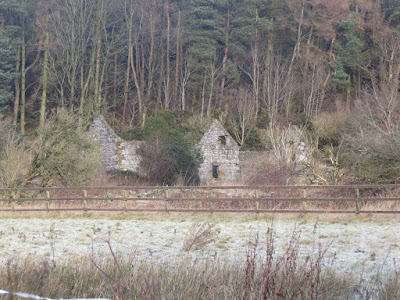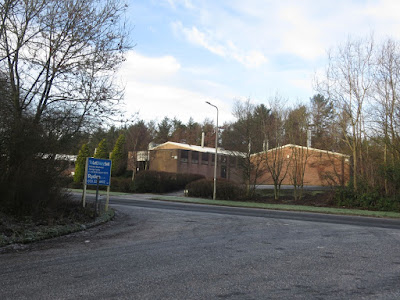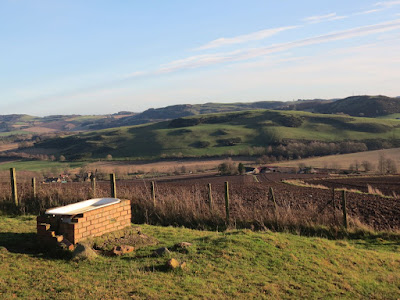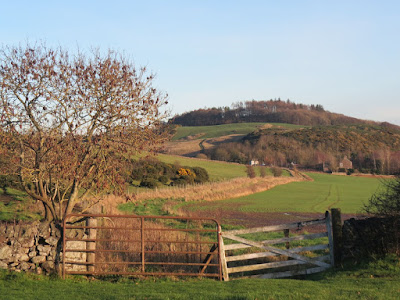Thornton was one of those places I seemed to have somehow missed passing through on all my Fife travels thus far. I kept seeing its name one one of the many roundabouts hereabouts and of course I'd seen it umpteen times taking up two gridsquares on the Ordnance Survey map, but I'd never actually visited it.
That was about to change, so I went about devising a route extending west from the village, seeing as I'd visited most of the gridsquares immediately to its east. I have to say, looking at the map, my expectations were not too high. There were few contour lines, so no height and it seemed to be quite an industrial area. What's more there was not a single item in Old English font marked on the map. Still, I would bag a trigpoint and some extra gridsquares, so I set off on what turned out to be a rather bright winter's day with my usual accouterments and a curious mind.
I quickly found a parking space on the main street and headed westwards along Strathore Road, stopping to take my first photo of the library.
 |
| Thornton Library - NT2897 |
One small consolation of walking along this long, straight and boring road was that there were several benchmarks to look out for. At least there was a pavement to walk along, and I could stride out quickly. That's right, Becky, focus on the positives. I tend to walk quickly when I can on these investigative walks to make up for the inevitable time spent photographing, looking for benchmarks, birds etc.
My first benchmark was an obvious one, although I photographed it surreptitiously, it being on a private home.
 |
| Strathore Road cottages. The benchmark is on the cottage furthest away. NT2897 |
 |
| Benchmark on Strathore Road cottage. NT2897 |
For the length of this road I was assailed by barking dogs and, judging from the size and speed of their movements, I was glad to see them well fenced in. Although the cowardly part of me envisaged sufficient power in their hind legs to be able to easily scale the fence. after the first lot of barking dogs, I anticipated my next gridsquare and benchmark at West Strathore. I could see the benchmark and was just about to photograph it when I noticed a figure standing int he shadows staring at me. I quickly changed my plan and walked past the farm before taking a photograph.
 |
| West Strathore. NT2797 |
To the south I could see the disused railway line and wished I was walking along it. I wondered whether it would be possible. After my recent experience with disused railway lines, I was not keen to try another one. Once bitten, twice shy. Still, it would be more pleasant than walking along this road with its plethora of Keep Out signs and barking dogs.
I persevered along concrete, glad to find and quickly photograph the next benchmark.
 |
| Benchmark on Strathore Cottages. NT2797 |
 |
| Benchmark location, Strathore Cottages. NT2797 |
Another gridsquare and another benchmark. How exciting! This was the last before I was due to turn off and I looked eagerly for my turn off point. Would it be somewhere obvious and not marked private?
 |
| Another Strathore Road benchmark. NT2697 |
 |
| Stone post - location of benchmark. NT2697 |
If it hadn't been for my desire to visit the trigpoint, I would have jointed the disused railway line at this point. I continued along the Strathore Road for a few yards more than necessary in order to find yet another benchmark. This one was on a railway bridge, from where I could see that it would be possible to walk along the railway line. Another time (if there is one) I will do that instead.
 |
| Benchmark on Strathore Road railway bridge. NT2697 |
 |
| Strathore Road railway bridge. NT2697 |
There was a private sign on the turn off to Strathore House, but I ignored itI always assume such signs are meant for vehicles and not pedestrians. I was not accosted at any rate. The trigpoint is unmissable, quite a boring one really.
 |
| Strathore trigpoint. NT2697 |
Although I nipped briefly into NT2698, I could see I would be revisiting that gridsquare later on for much longer and potentially when not overlooked, so I continued into the next gridsquare. As you can see from the photos, it was very slippy underfoot and I lamented the fact I had not donned my slip on ice spikes, which make a great deal of difference when walking on ice.
Once past Strathore House, I paused to take a photograph of the gridsquare, although I would be in this one later on as well.
 |
| Track west from Strathore House. NT2598 |
At a T-junction I turned left and then right. I could see the railway line and again wished I could join it, but I couldn't see a way past the private house. I would just have to wait.
 |
House near Skeddoway. NT2597
|
At the B922 I went down onto the railway tunnel and walked underneath the B road and continued along the railway track, looking for somewhere to eat my lunch.
 |
| Railway bridge over disused railway line. NT2497 |
 |
| Disused railway line near Kinglassie. NT2497 |
 |
Disused railway line near Kinglassie. NT2498
|
I wanted to find somewhere to eat my lunch before reaching Kinglassie as I thought it might be more difficult then. I ended up sitting on the railway line and watching Bullfinches and other small birds flit around making the occasional alarm call.
I visited NT2498 very briefly before leaving the railway line at Kinglassie. This was another place I had seen signposted many times and I once corresponded with someone from this village, so I was more than a little curious to see it. I knew it was once a mining village, like so many places in east Fife.I walked past the erstwhile colliery and the row of mining cottages which were built for the miners and their families. Work on the pit began in 1908 and by 1955 over 760 men were employed there. The pit closed in 1966.
Today there seemed to be little to see here, although I did only skirt the eastern end of the village. I photographed the school and its benchmark as the square's requisite subject.
 |
| Kinglassie Primary School. NT2398 |
 |
| Kinglassie Primary School benchmark. NT2398 |
I turned right at the Mining Museum and joined the Pilgrim's Way, which was signposted to Markinch 8 miles away.
 |
| Kinglassie Mining Museum and Pilgrim's Way. NT2398 |
I was climbing steeply now (after saying there were no hills!) and was not making as much headway as the red-coated Greyhound to my right. It was speeding uphill in chase of a hare. Below, a woman with a huge bear-like brown dog was watching it. Why wasn't she calling it back? I stood with my heart in my mouth and watched, willing the hare to escape. There was another rabbit or hare further away too. Oh, how I hoped they would both escape. I can't be certain because both hare and dog disappeared into the vegetation, at which point, the hare was well ahead of the dog. The woman then found her voice and caller her dog to heel and it returned empty mouthed. I had ascended the hill without thinking much about it and opened the gate for the culprit to get out. I know they're only doing what comes naturally to them, but I hate to see it. It's one of the reasons I would never own a dog.
I now spotted a lone tower in the distance, in another gridsquare. I checked the map. It was Blythe's Tower. I couldn't see a way to access it, but it would have to wait for another occasion. It was built in 1812 and was used as a lookout tower by the Home Guard in WWII. For now, I would satisfy myself with a distant photo of it and do further investigations before my next visit.
 |
| Blythe's Tower from NT2399 |
The footpath now led right between a fence and a wall towards Finmont farm. There were other people on the path ahead of me.
 |
| Footpath near Finmount Farm. NT2399 |
After passing the farm, I turned right at a T-junction and joined a minor road briefly before turning off towards Fife airport.
 |
| Sign for Fife Airport. NT2399 |
I wasn't sure if this was where my son had done his skydive for his 21st birthday several years ago. In any case, my mind turned to that event when mum was still with us and when my son had gone piggy back on a stranger's back for his first (and only) skydive; when he had sat in a 'classroom' with several other unmasked people and when my family had come together to witness this important event. None of that was possible now; it was another world away, a world that seemed strange, distant and alien. How quickly and thoroughly our new world and rules has enveloped us and completely altered our mindset, that I should balk at the thought of things which only a year ago had been completely normal. Balk and yet yearn for that strange world too. When would it return?
Pondering these rather morbid thoughts, I walked past Goatmilk Farm with its incongruous mnonkey puzzle tree and the diminutive Goatmilk hills in the background.
 |
| Goatmilk Farm. NT2499 |
There was supposed to be a benchmark at the entrance to Fife Airport, but I didn't spend long looking for it as there was a car parked there with the driver inside. I always feel a little self-conscious looking for benchmarks in public, so I gave the area a quick, futile glance and continued on my way.
My eye is always drawn to ruins and East Goatmilk looked like it might be worth a further explore, if I could get there that was.
 |
| East Goatmilk. NT2499 |
Shortly after this my letters changed from NT to NO - always an exciting moment. I was only in the gridsquare briefly and guessed there was a golf course coming up as there had been a sign warning drivers to slow down. Sure enough, two golfers crossed the road ahead of me. I nipped across simply to photograph the best view of the golf course - always difficult!
 |
| Glenrothes Golf Course. NO2400 |
I now came across my 6th benchmark of the day and one I was not expecting to see. It was on a milestone and I can only think that I had omitted this gridsquare in my preparations for the walk, perhaps because I wouldn't be in it for very long.
 |
| Milestone near Glenrothes Golf Course. NO2500 |
I was glad to see that there was a path running south by the side of the golf course. I joined this path and walked south for what was the most boring part of the walk - into an industrial estate. At least there was a benchmark here, I thought to myself as I nipped round a corner to search for it. the sight was disgusting. Here beside the busy B921 was a very popular fly tipping site; an alarm went off at my approach, so I quickly retreated, forgetting about the benchmark - nothing is worth that. Feeling very flat and finding it hard to muster any enthusiasm for the rest of the walk, I plodded along an icy pavement through the Industrial Estate.
 |
| Whitehill Industrial Estate. NT2599 |
I was back in NT territory and couldn't wait to get out. Just as I was beginning to think I was going to have to retrace my steps back through the Industrial estate, a cycle route appeared. I've never been more happy to see one. I emerged onto the busy dual carriageway and initially wondered how I would get across. Moreover, how was I going to continue my walk? The route I had drawn went through Home Farm directly opposite, but there didn't appear to be a right of way there. Like it or not, I was going to have to escape somehow.
A break in the traffic allowed me to cross the road and I plucked up courage to go into Home Farm entrance and quickly turn left onto what I hoped was a public right of way.
 |
| Track south from Home Farm. NT2598 |
Anyone who is still with me might be wondering why I have entitled my post as the Guns of Strathorone and the reason is about to become clear. For most of the duration of the walk there had been the sound of occasional gunshot. It was now constant ad accompanied me until the end of my walk. There are few things I abhor more. Culling pheasants to keep the numbers down and grain safe is one thing, but breeding gamebirds to shoot is quite another and it is commonplace throughout the UK. Claypigeon shooting is simply a way of practising this 'sport' and it is noisy and potentially dangerous.I rarely walk these days without hearing the sound of gunshot piercing the air. Mostly I can filter it out but today it was impossible; the longest period without a shot that I counted for the final two hours of my walk was 30 seconds. For that reason alone I would not recommend this walk to anyone.
Which is a shame, because I was now coming to the nicest part. I approached Lochty Burn and Strathore Woods and looked for somewhere to sit with my final cup of tea.
 |
| Strathore Woods. NT2598 |
 |
| Lochty Burn. NT2598 |
This is where the nicest thing of the day happened. As I sat quietly watching the tranquil waters of the burn flow past, a tiny high-pitched sound vied with the sound of the gunshot. It was a Goldcrest, oblivious to my presence and I managed to photograph it as it flitted about in the bush next to me.
 |
| Goldcrest by Lochty burn. NT2598 |
I continued along the banks of Lochty Burn, opposite Strathore House, from whence it sounded like the shooting was coming, and soon happened upon quite a serious obstacle. The bridge had given way leaving no way of crossing the burn. It doesn't appear very wide on the photograph, but it was wider and more difficult than it looked. Bravely I proceeded to jump across.
 |
| Where I had to jump across the burn. NT2698 |
Gradually I came upon other walkers, the first I had encountered during the day. There were several footpaths to choose, but I stuck to the one I had marked out until I came to Stenton Pond, which was without doubt my favourite part of the walk - and where I added several new species to my embarrasing bird list.
 |
| Stenton Pond. NT2798 |
 |
| Herring Gulls and Moorhen on frozen Stenton Pond. NT2798 |
 |
| Moorhen on frozen Stenton Pond. NT2798 |
I crossed a footbridge across the pond and entered my final gridsquare of the day. I was glad I'd done the walk this way round and left the best till last.
 |
| Stenton Pond. NT2898 |
Several Bullfinches came to say hello as I passed through the final bit of woodland before hitting urbanisation again. I love Bullfinches and I had seen so many this autumn/winter. They form flocks for safety during the cold months before pairing off in the spring, when they defend their territories like all other birds.
 |
| Bullfinch near Stenton Pond. NT2898 |
I had one more benchmark to look out for as I strode the streets of Thornton back to my car. It was on the church.
 |
| Thornton Church benchmark. NT2897 |
 |
| Thornton Church. NT2897 |
Only now was the sound of gunshot silent. My expectations had been met for this walk, although there were some saving graces. Still, I won't rush back for this one.
Number of new gridsquares: 16
Number of miles walked: 11.6
Number of benchmarks: 7
Number of trigpoints: 1
Walk worth repeating: No,but I have since heard about two historic hospitals near my route, which I would like to visit and I'd like to explore the Goatmilk hills some more.
Highlights: Goatmilk Hills, Stenton Pond, Goldcrest, Bullfinches.













































































